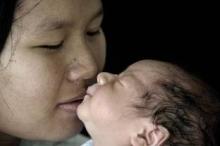SANTA BARBARA, CALIF. – Although there are hints, researchers remain largely baffled about why ethnic minority patients have lower pregnancy and live birth rates than do whites when they undergo in vitro fertilization, especially as natural conception rates do not appear to be disparate.
Many potential explanations have been hypothesized, including differences in obesity rates, leiomyomata prevalence, inflammatory processes, and estrogen metabolism, Dr. Marcelle I. Cedars said at a meeting on in vitro fertilization and embryo transfer, which was sponsored by the University of California, Los Angeles.
 Photo credit: ©oneclearvision/iStockphoto.com
Photo credit: ©oneclearvision/iStockphoto.com
"If we looked at live birth rate overall in any age group, we saw a significantly decreased rate in the Asian population," said Dr. Marcelle I. Cedars, director of the in vitro fertilization program and director of the division of reproductive endocrinology and infertility at UCSF.
None seem to fully account for diminished IVF outcomes in Asian Americans, blacks, and Hispanics. Pregnancy loss rates associated with assisted reproductive techniques also are higher for blacks and Hispanics, she noted.
Economic disparities and unequal access to IVF have been suggested as playing a role, but military studies, in which all patients have equal access to care, confirm reduced outcomes numerically – although the numbers did not quite reach statistical significance.
Dr. Cedars’ group at the University of California, San Francisco (UCSF), has focused on IVF outcomes in Asian Americans, who represent approximately a third of their patient population. Differences came under scrutiny beginning about 6 years ago.
"If we looked at live birth rate overall in any age group, we saw a significantly decreased rate in the Asian population," said Dr. Cedars, director of the in vitro fertilization program and director of the division of reproductive endocrinology and infertility at UCSF.
The clinical pregnancy rate among Asian patients also was lower than among white patients in their clinic, but the number of eggs, number of embryos, and number of high-quality embryos were similar.
"We don’t think there is something intrinsically different in terms of their ovarian reserve," she said.
Further investigation revealed higher estradiol levels during stimulation in Asian patients, even among those on a strictly controlled regimen, when "everyone gets the same dose," she noted.
Asian oocyte donors, like IVF patients, had peak serum estradiol rates 23% higher than those of white donors, but their implantation, clinical pregnancy, and live birth rates were not statistically different.
Environmental or lifestyle factors, such as higher rates of mercury exposure through fish consumption, have been hypothesized as contributing to poorer IVF outcomes, said Dr. Cedars, who also is a professor of obstetrics, gynecology, and reproductive sciences at UCSF.
But such a factor would influence spontaneous conception and pregnancy as well as IVF.
"When we looked at spontaneous pregnancies and time to pregnancy, there were absolutely no decrements in the Asian population," she said.
Indeed, Dr. Cedars believes more attention should be focused on possible differences in the way patients metabolize drugs used during ovarian stimulation. "I think we really need to think about our stimulation protocols, which were not developed with [proportional representation] of these minorities."
In the meantime, "much still remains to be explained, and this is an active area for investigation," she concluded.
Dr. Cedars reported no financial relationships relevant to her talk.

